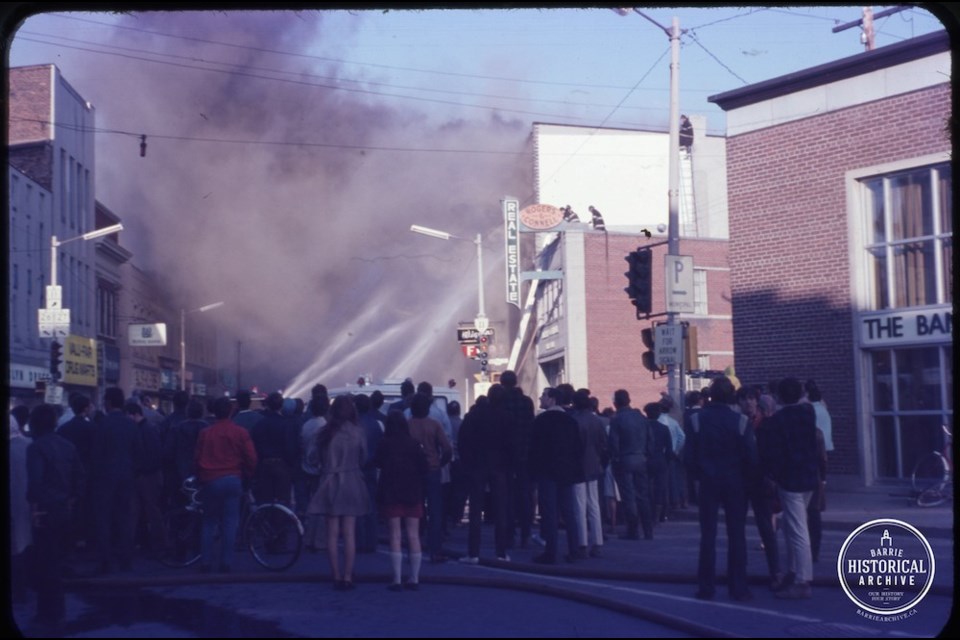I would like to tell you that the destructive fires in this seemingly highly combustible town are all in the past, but that is obviously not the case.
In my time in Barrie, I have seen the Sam the Record man shop fall, the Wellington Hotel tumble, and a corner of Mary and Dunlop streets emptied by flames.
As solid as the 19th-century brick and stone work is, very old and dry timbers rest beneath with layers of alterations, old wiring and assorted debris in the mix. The threat of fire is always there.
Perhaps not immediately noticeable in the downtown core are some Victorian buildings that are quite a bit shorter than their neighbours. You may think that they were built that way but, in truth, they have lost an upper floor that could not be repaired and was simply removed.
An excellent example, which fooled me for years, is the former Bank of Montreal building to the west of Meridian Place. In the Guthrie Story, I learned that the former music hall was partially destroyed in a 1909 arson caper that captivated the small town of Barrie.
More recently was a fire that occurred in the spring of 1970, which threatened to destroy the entire Glebe Block, but ending up forever altering the look of nearly half of it. From Five Points, on the south side of Dunlop Street East, to the Il Bucco Restaurant at 31 Dunlop St. E., several buildings shrank by one full storey.
The Barrie Examiner headline read: “City’s Worst Fire of the Century Ravages Downtown Block” on April 24, 1970, one day after the conflagration.
Around 4 p.m., on April 23, a young girl ran from a third-floor apartment and reported a fire. The local fire service responded quickly, but high winds pushed the flames eastward.
By 5 p.m., four buildings were ablaze.
Barrie wisely made calls to fire departments in the surrounding area. The fire, as it was being battled by multiple agencies, quickly became the biggest thing in town and drew a large crowd. The fire itself fortunately hurt no one, but the collapse of a brick wall injured a number of onlookers.
The most badly injured was Patricia Barham, a 24-year-old secretary at Household Finance, who suffered a fractured skull and was transported to Toronto General Hospital in critical condition. In time, she recovered.
In all, 24 people were left homeless by the fire and several street-level businesses – including Mel Brass, Household Finance and Laura Secord – were heavily damaged.
This disaster brought out the best in Barrie. Service groups, local businesses and citizens jumped into action to do all that they could for the unfortunate people involved in the disruptive event.
The United Cigar Store, longtime location of the Player’s Store, now the Dunlop Diner, opened its doors that afternoon for fire personnel only. Burger Chef, which was located where the now-closed Crock & Block sits, brought in more food, as did Loblaws and A&P.
A Salvation Army van parked near Five Points and remained for the duration of the operation, handing out food and coffee, co-ordinating requests for bedding and clothing, and relaying information to concerned community members.
When the fire was extinguished and the 5,000 gallons of water used somewhat dried, the task that followed became what to do with a half-destroyed city block. Engineers discussed a complete razing of the burned section, but, in the end, the lower portions of the historic structures were seen to be salvageable.
The cause of the fire was discovered to have resulted from a child playing with matches in one of the third-floor apartments.
Upon stone foundations, some laid in the 1840s, wood buildings rose here that were burned down in 1871. Their brick replacements were nearly destroyed again in 1875, and the flames tried one more time in 1970 and only succeeded in getting one floor.
Roll on, Glebe Block!
Each week, the Barrie Historical Archive provides BarrieToday readers with a glimpse of the city’s past. This unique column features photos and stories from years gone by and is sure to appeal to the historian in each of us.



